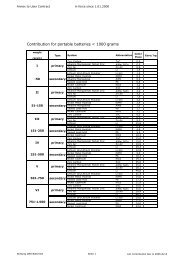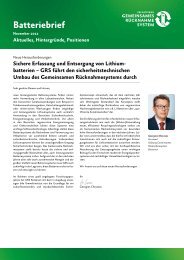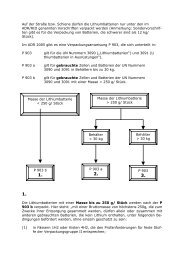The World of Batteries - GRS-Batterien
The World of Batteries - GRS-Batterien
The World of Batteries - GRS-Batterien
Create successful ePaper yourself
Turn your PDF publications into a flip-book with our unique Google optimized e-Paper software.
4<br />
THE WORLD OF BATTERIES – FUNCTION, SYSTEMS, DISPOSAL<br />
Erster First Section: Teil: Die <strong>The</strong> Entwicklung Development und and die Functionality Funktion der <strong>of</strong> Gerätebatterien<br />
Consumer <strong>Batteries</strong><br />
1789<br />
Beginnings<br />
<strong>The</strong> history <strong>of</strong> electro-chemical energy storage began with scientific<br />
investigations into electricity. Names such as Luigi Galvani (1737-1798)<br />
and Alessandro Volta (1745-1827) are associated with this work and<br />
live on today in terms such as “galvanic cell” and “volt”. In 1789, while<br />
conducting an experiment, Galvani noticed that the legs <strong>of</strong> a frog began<br />
to twitch when they came into contact with two different types <strong>of</strong> metal.<br />
He concluded there was a connection between electricity and muscle<br />
activity.<br />
Ten years later, Volta constructed the first simple battery. He put together<br />
alternating discs <strong>of</strong> copper and zinc in a column, with a sheet <strong>of</strong> paper<br />
soaked in a salt solution inserted between each <strong>of</strong> the layers. <strong>The</strong> “Voltaic<br />
pile” produced electricity when the plates were connected together<br />
with wire. Higher voltage could be extracted when several piles were<br />
connected in series.<br />
Johann Wilhelm Ritter (1776-1810), who worked with Goethe in the area<br />
<strong>of</strong> natural science, developed a battery in 1802, the so-called “Ritterian<br />
pile”. <strong>The</strong> pile consisted <strong>of</strong> layers <strong>of</strong> copper and cardboard soaked in a<br />
table salt (sodium chloride) solution. <strong>The</strong> device could be charged with<br />
electricity and released current on discharge. <strong>The</strong> pile is considered to<br />
be the fore-runner <strong>of</strong> the accumulator, the rechargeable battery.<br />
In the following centuries work on galvanic elements continued intensively<br />
and by the dawn <strong>of</strong> the 20th century, the original battery, which<br />
could only be operated while stationary, had been developed into a<br />
supremely practical dry element. <strong>The</strong> French engineer Georges Leclanché,<br />
the German physician Dr Carl Gassner (1855-1942) and Paul Schmidt<br />
(1868-1948) were instrumental in its development. Leclanché invented<br />
the manganese dioxide zinc cell with ammonium chloride acting as the<br />
electrolyte. <strong>The</strong> cell is still in wide use today. At a later date, Gassner and<br />
Schmidt succeeded in thickening the previously liquid electrolytes, hence<br />
laying the foundations for transportable batteries.<br />
History <strong>of</strong> the development <strong>of</strong> the battery<br />
1600 Gilbert (England) First electro-chemical experimentation<br />
1789 Galvani (Italy ) Discovery <strong>of</strong> electricity while experimenting with<br />
animals/frogs<br />
1800 Volta (Italy) Discovery <strong>of</strong> the Volta cell/”Voltaic pile”<br />
1802 Cruickshank (England) First electric battery for mass production<br />
1802 Ritter (Germany) First accumulator “Ritterian pile”<br />
1820 Ampère (France) Discoverer <strong>of</strong> electromagnetism<br />
1833 Faraday (England) Publication <strong>of</strong> Faraday’s Law<br />
1836 Daniell (England) Discovery <strong>of</strong> the “Daniell elements”/galvanic cell<br />
1859 Planté (France) Invention <strong>of</strong> the lead acid battery<br />
1860<br />
Leclanché (France) Invention <strong>of</strong> the “Leclanché cell” manganese dioxide<br />
zinc element<br />
1888<br />
Gassner / Schmidt<br />
(Germany)<br />
Invention <strong>of</strong> dry cells<br />
1899 Jungner (Sweden) Invention <strong>of</strong> the nickel-cadmium battery<br />
1901 Edison (USA) Invention <strong>of</strong> the nickel metal hydride battery<br />
1932 Schlecht & Ackermann<br />
(Germany)<br />
Invention <strong>of</strong> sintered electrodes<br />
1947 Neumann (France) Successful sealing <strong>of</strong> the nickel cadmium battery<br />
1960 Union Carbide (USA) Development <strong>of</strong> the alkaline manganese battery<br />
1970 Development <strong>of</strong> the valve-regulated lead acid battery<br />
1990<br />
Commercialisation <strong>of</strong> nickel metal hydride battery<br />
(e.g. for vehicles)<br />
1992 Kordesh (Canada) Commercialisation <strong>of</strong> rechargeable alkaline manganese<br />
batteries<br />
1999 Commercialisation <strong>of</strong> lithium ion polymer batteries<br />
2002<br />
2006<br />
Limited manufacture <strong>of</strong> fuel cells (PEM, for consumer<br />
batteries and vehicles)<br />
First MP3 player with “bacteria batteries” (not yet commercially<br />
viable)<br />
2007 First “paper batteries” (not yet commercially viable)<br />
<strong>The</strong> principle <strong>of</strong> chemical storage <strong>of</strong> electrical energy is probably very much older.<br />
As early as approx. 250 BC, the Parthians were using clay pots, into which was inserted<br />
a copper plate and iron rod. This has been proposed as evidence that even then man<br />
had some understanding <strong>of</strong> galvanisation. <strong>The</strong> Egyptians are said to have manufactured<br />
copper plating galvanized with antimony some 4,300 years ago.














